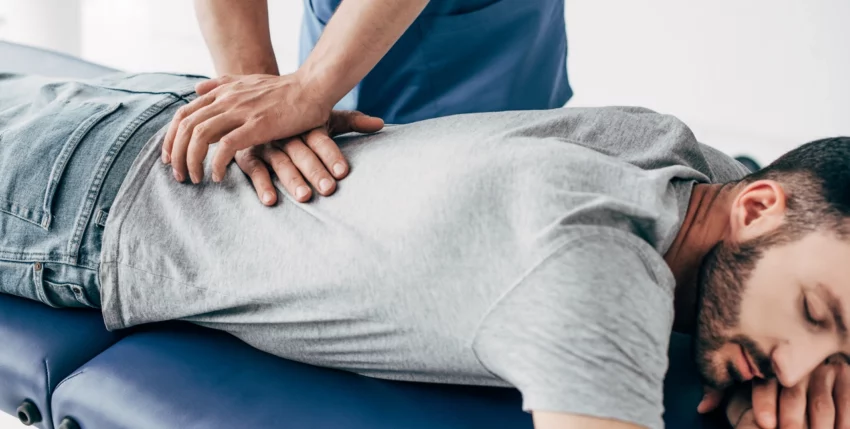
Trusted Physiotherapy for Back Pain in Downtown Calgary
Are you struggling with lower back pain and seeking reliable solutions in downtown Calgary? Welcome to Avenue Physio’s comprehensive guide, where we debunk common myths and provide expert insights into managing and treating lower back pain.
Whether you’re experiencing your first episode or dealing with recurrent discomfort, our blog post delves into the effectiveness of physiotherapy and offers practical advice for those seeking relief. Join us as we explore the truths behind back pain and how professional physiotherapy can make a significant difference in your life.
What Can I Do To Relieve My Lower Back Pain?
KNOW THE FACTS!
Low back pain is common. It has the highest prevalence globally among all musculoskeletal conditions and is the leading cause of disability worldwide. People can experience low back pain at any age and most people will experience low back pain at some point in their lives.
“Four out of Five Canadians will experience at least one episode of Low back pain within their lifetime.” Physical Therapy. 1999;79:384–396
“Most common treated disorder in outpatient physical therapy practice.” Phys Ther 1994; 74 (2): 101-110
There are a lot of myths and misconceptions about low back pain. Firstly, knowing the facts about low back pain can help.
MYTH OR FACT
“Low back pain is usually a serious condition.”
MYTH
Low back pain can be very painful and decrease your mobility, but the majority of the time low back pain is not caused by serious conditions and will usually improve with time.
In general, if the low back pain has come on suddenly and is not accompanied by other symptoms like weakness, numbness or problems with your bowel or bladder it is more likely not serious.
If your pain persists or worsens or is accompanied by other symptoms you should follow up with a physiotherapist or your family doctor.
MYTH OR FACT
“I have back pain because something is out of place and needs to be put back in.”
MYTH
Our discs are not Jelly donuts with the filling squeezing out. Backs are not delicate structures. Our backs are adaptable, strong and able to tolerate force.
Good news is that nothing is out of place that is causing your Low back pain.
Our low back does not slip, sublux or go out of place! This terminology is wrong and scary. Backs are strong. If you have had an injury, tissue healing takes 3 months. So if pain persists past this time it usually means there are other contributing factors.
MYTH OR FACT
“LBP will become persistent and deteriorate in later life.”
MYTH
Although it is a widespread belief and concern that getting older causes or worsens back pain, research does not support this, and evidence-based treatments can help at any age.
It’s not uncommon for people to experience more frequent episodes of low back pain as they age. However, it is important to know that aging doesn’t guarantee the development of low back pain and not everyone will experience it as they get older. Maintaining a healthy lifestyle, including regular exercise and weight management can help reduce the risk of developing back pain and its severity.
MYTH OR FACT
“Scans are always needed to diagnose the pain.”
MYTH
In most cases, imaging is not needed. During the mid-90’s imaging became common and caused many unnecessary tests and ineffective treatments based on imaging findings. Findings like disc bulges, disc degeneration and arthritis are common and normal in most people who experience no pain especially as they get older.
“Unnecessary MRI scans can actually have a very negative psychological effect on LBP patients, as this fear of damage can erode some people’s confidence in the strength and resilience of their spine.” Spine. 2001;26:1158.
MYTH OR FACT
“Activities that provoke pain should always be avoided and rest is needed to heal.”
MYTH
As we stated earlier the body is excellent at healing itself. If you have an injury it takes 3 months for the body to heal. Movement can still be painful after this healing takes place. The pain you are feeling is more related to how sensitive the structures in your back have become – not how damaged you are. So it is safe and normal to feel pain as you start to return to your normal activities and exercise. This will usually settle down as you exercise more. In fact, exercise and movement are one of the most effective ways to treat low back pain.
MYTH OR FACT
“I continue to have low back pain because my core is weak and I have poor posture.”
MYTH
Continuing to hold in your stomach and sit up tall and stiff does not help low back pain. Tensing your muscles up to protect your back increases the load on your back. Muscles need to switch on and off depending on the activity. Tensing your abdominal and back muscles all day like you are going to lift up a piano is not helpful.
Contrary to popular belief how we sit and stand does not cause low back pain even when these postures are painful. It is safe to relax during everyday tasks and is actually more efficient!
How Effective Is Physiotherapy for Back Pain?
The majority of people with low back pain will respond and improve with physiotherapy treatment. For patients who experience ongoing pain (lasting longer than 3 months) the key to effective treatment is to understand why you have low back pain.
There are many contributors to ongoing low back pain. Being stressed, not sleeping, carrying extra weight, inactivity, smoking and overdoing it can all lead to persistent pain. Identifying the contributors to ongoing pain and dysfunction is important for effective treatment.
What Does a Physiotherapist Do for Back Pain?
Physiotherapists employ a variety of techniques to treat low back pain, tailoring their approach to the specific needs and condition of each individual.
- Education: A physiotherapist will explain what is causing your pain and give you ideas to modify it.
- Exercise Prescription: Specific exercises designed to improve mobility and flexibility of the spine and enhance overall spinal stability. These exercises aim to address muscle imbalances and decrease pain sensitivity.
- Manual Therapy: Hands-on techniques, such as massage, joint mobilization, and manipulation, may be used to alleviate pain, improve joint mobility, and reduce muscle tension.
- Intramuscular stimulation: Dry needling techniques may be used to decrease muscle tension and to help reduce pain sensitivity.
- Patient Empowerment: Physiotherapists empower patients with self-management strategies, including exercises for home and tools for preventing future episodes of back pain.
- Progressive Treatment Plans: Treatment plans so you have a clear path and understanding of how to take control of your pain and symptoms and get back to the activities that you love.
Should I Go to a Physiotherapist or Chiropractor for Lower Back Pain?
You should go to a health professional who takes the time to listen to you and understand your story and what caused your low back pain. If you have not improved with treatment after 6-12 weeks you should see a professional who is addressing all the contributors to your pain. You need to be an active participant in managing your symptoms.
You should see a health professional that empowers you to relax and move more confidentiality in your body without fear. A professional that supports you and encourages you to use self-pain management strategies and educates you on contributing lifestyle habits.
How Long Does It Take for Physical Therapy To Help Lower Back Pain?
The duration for low back pain to improve with physiotherapy can vary widely depending on the cause, severity, and contributing factors.
In many cases, people experience relief within a few weeks of starting physiotherapy. And the majority of people’s pain resolves in 3 months.
For a smaller group of people (up to 30%) pain may persist past 12 weeks and start to disrupt many aspects of their life. This can be scary and start to affect mood and anxiety. This is why back pain is the leading cause of disability and why getting the right treatment is important.
When Should I See a Physio for Back Pain?
It is a good idea to see a physiotherapist especially if:
- Pain is persistent: If the pain has been present for more than a few days or is not improving with rest and self-care measures.
- Pain is recurrent: If you’ve had multiple episodes of low back pain, even if they were resolved in the past.
- Pain is accompanied by other symptoms: If you experience symptoms like numbness, tingling, weakness, or pain radiating down your legs, these could indicate more serious issues.
- Difficulty with daily activities: If the pain is impacting your ability to perform everyday tasks, work, or exercise.
- History of spinal issues: If you have a history of spinal conditions or surgeries.
Key Takeaways
Managing lower back pain effectively requires understanding the facts, dispelling myths, and seeking professional guidance. At Avenue Physio Physio in downtown Calgary, we are committed to providing you with the highest quality physiotherapy care to address your back pain concerns.
Remember, every back pain journey is unique, and our tailored approaches are designed to meet your specific needs. Don’t let back pain hold you back any longer. Reach out to us today and take the first step towards a pain-free life with confidence and assurance.

